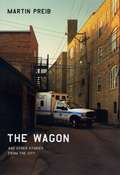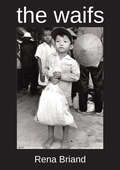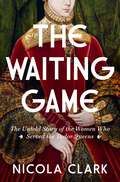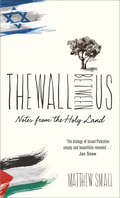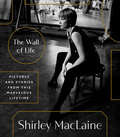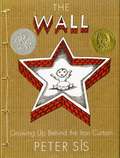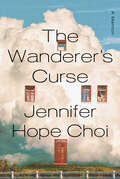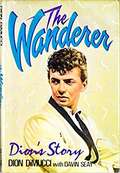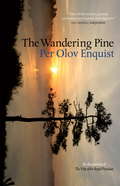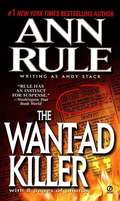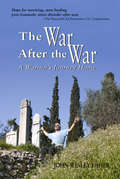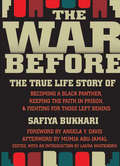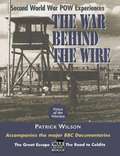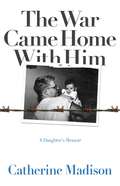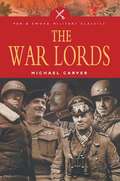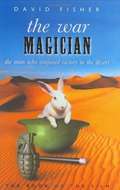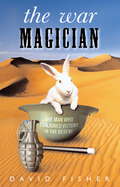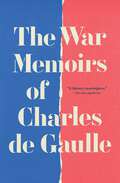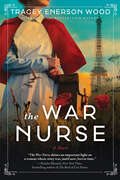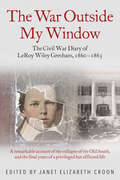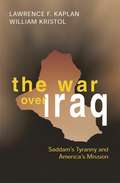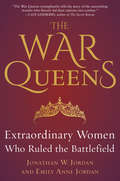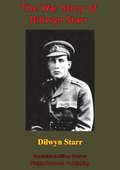- Table View
- List View
The Wagon and Other Stories from the City
by Martin PreibMartin Preib is an officer in the Chicago Police Department--a beat cop whose first assignment as a rookie policeman was working on the wagon that picks up the dead. Over the course of countless hours driving the wagon through the city streets, claiming corpses and taking them to the morgue, arresting drunks and criminals and hauling them to jail, Preib took pen to paper to record his experiences. Inspired by Preib's daily life as a policeman, The Wagon and Other Stories from the City chronicles the outer and inner lives of both a Chicago cop and the city itself. The book follows Preib as he transports body bags, forges an unlikely connection with his female partner, trains a younger officer, and finds himself among people long forgotten--or rendered invisible--by the rest of society. Preib recounts how he navigates the tenuous labyrinths of race and class in the urban metropolis, such as a domestic disturbance call involving a gang member and his abused girlfriend or a run-in with a group of drunk yuppies. As he encounters the real and imagined geographies of Chicago, the city reveals itself to be not just a backdrop, but a central force in his narrative of life and death. Preib's accounts, all told in his breathtaking prose, range from noir-like reports of police work to streetwise meditations on life and darkly humorous accounts of other jobs in the city's service industry. Here, Preib's universe of police officers, criminals, and victims--and everyone in between--comes alive in ways that readers will long remember.
The Waifs
by Rena BriandA fascinating story for anyone interested in the adoption of vulnerable mixed-race children abandoned in the aftermath of war. When Rena Briand adopted Tuyen, a Vietnamese orphan, and successfully brought her to Australia, dozens of families aspired to do the same. Rena Briand's "The Waifs" is a compelling story about battling officialdom with resilience and determination. A tale on how a handful of compassionate women fought to get a few Vietnamese waifs to Australia. Their opponents were formidable - conniving politicians hypocritical church leaders racist social workers and the phony "charitables" of Toorak. A moving and courageous story.
The Waiting Game: The Untold Story of the Women Who Served the Tudor Queens: A History
by Nicola ClarkA colorful and authoritative narrative history of the often-overlooked—yet hugely influential—figures of the Tudor court: the ladies-in-waiting.Every Tudor Queen had ladies-in-waiting. They were her confidantes and her chaperones. Only the Queen's ladies had the right to enter her most private chambers, spending hours helping her to get dressed and undressed, caring for her clothes and jewels, listening to her secrets. But they also held a unique power. A quiet word behind the scenes, an appropriately timed gift, a well-negotiated marriage alliance were all forms of political agency wielded expertly by women. The Waiting Game explores the daily lives of ladies-in-waiting, revealing the secrets of recruitment, costume, what they ate, where (and with whom) they slept. We meet María de Salinas, who traveled to England with Catherine of Aragon when just a teenager and spied for her during the divorce from Henry VIII. Anne Boleyn's lady-in-waiting Jane Parker was instrumental in the execution of not one, but two queens. And maid-of-honor Anne Basset kept her place through the last four consorts, negotiating the conflicting loyalties of her birth family, her mistress the Queen, and even the desires of the King himself. As Henry changed wives—and changed the very fabric of the country's structure besides—these women had to make choices about loyalty that simply didn't exist before. The Waiting Game is the first time their vital story has been told.
The Wall Between Us: Notes from the Holy Land
by Matthew Small&“The biology of Israel/Palestine simply and beautifully revealed,&” from the author of Down and Out Today: Notes from the Gutter (Jon Snow, journalist and presenter). Writer Matthew Small traveled to the Holy Land to further his understanding of the enduring conflict between Israel and Palestine. While there, he discovered beauty, fear and suffering like nowhere else in the world. In these honest and evocative reflections, Small retells his experiences of crossing into the West Bank to work the olive harvest with Palestinian farmers. He relates his encounters with organizations that are determinedly working to sow the seeds of peace in soils that are deeply scarred by suffering and war. While reliving these unforgettable experiences, through his writing he struggles to find why the wall between these two groups of people exists. Deciding to join a group of international and Israeli volunteers, Small attempts to show that, despite the ongoing occupation, peace is not lost, but still to be discovered. &“Matthew Small, despite the horror of both the war, and the wall, works and travels both sides of the divide, and brings us to an understanding of where the seeds of peace can yet be found.&”—Jon Snow, journalist and presenter &“What is really refreshing about this book is the way Small writes from a very personal perspective, often admitting in his diary entries that he&’s unsure what to write or how he feels about the situation. His emotion surrounding his visit and the people living amongst the occupation every day is portrayed in a gritty, raw way.&”—The Bookbag
The Wall of Life: Pictures and Stories from This Marvelous Lifetime
by Shirley MacLaineAcademy Award-winning actress and New York Times bestselling author Shirley MacLaine shares a dazzling memoir in photographs, chronicling her extraordinary life with 150+ images from her personal archiveWith more than seventy years on the silver screen, Shirley MacLaine has, as she says, seen it all, done it all, been everywhere, and met everyone. Since making her Hollywood debut in 1955, her popularity has only grown as she&’s amassed a stunning collection of awards and written multiple bestselling memoirs.Now, at ninety years old, MacLaine has more stories to tell and the pictures to bring them to life. By introducing readers to her extensive photo collection—which she calls her &“wall of life&”—MacLaine reveals both intimate family memories and images with some of the most significant figures from entertainment and politics. With wit and charm, she reflects on each photo, exploring ambition, love, friendship, motherhood, art, political activism, curiosity, and more.Charting the course of her remarkable life and career, MacLaine shares both early memories (her childhood with her brother, Warren Beatty; her decision to leave for New York City at age sixteen; her early work dancing on Broadway) as well as remembrances of her days in the public eye (campaigning for George McGovern, traveling to meet political luminaries, starring in legendary film roles, and developing an interest in spirituality).Along the way, readers gain greater insight into figures such as Frank Sinatra, Dean Martin, Bob Fosse, Jack Nicholson, the Dalai Lama, Fidel Castro, Mikhail Baryshnikov, and many more. Whether she's sharing what advice Elvis Presley asked her for, how she consoled close friend Elizabeth Taylor after the death of her husband, or which head of state she discussed UFOs with, MacLaine offers her most visual and delightful book yet, giving readers an unprecedented glance into a life like no other.
The Wall: Growing Up Behind the Iron Curtain
by Peter SísThrough journals, maps, and dreamscapes, Peter Sís shows what life was like for a child who loved to draw, proudly wore the red scarf of a Young Pioneer, stood guard at the giant statue of Stalin, and believed whatever he was told to believe. But adolescence brought questions. Cracks began to appear in the Iron Curtain, and news from the West slowly filtered into the country. Sís learned about beat poetry, rock 'n' roll, blue jeans, and Coca-Cola. He let his hair grow long, secretly read banned books, and joined a rock band. Then came the Prague Spring of 1968, and for a teenager who wanted to see the world and meet the Beatles, this was a magical time. It was short-lived, however, brought to a sudden and brutal end by the Soviet-led invasion. But this brief flowering had provided a glimpse of new possibilities- creativity could be discouraged but not easily killed. By joining memory and history, Sís takes us on his journey: from infant with paintbrush in hand to young man borne aloft by the wings of his art. <P><P> Winner of the Sibert Medal
The Wanderer's Curse: A Memoir
by Jennifer Hope ChoiA Korean mother runs off to Alaska, sparking a greater season of wandering. Could her daughter be destined for the same? When Jennifer Hope Choi first stumbled upon the “curse” known as yeokmasal—an allegedly inheritable affliction causing one to roam farther and farther from home—she immediately consulted her mother. “Oh yeah,” Umma quipped. “I have that.” Technically this wasn’t a revelation. Since 2007, the no-nonsense open-heart surgery nurse had moved suddenly from the Golden State to the Last Frontier, shuttling over the next decade through seven states. For much of her adulthood, Choi had fancied herself nothing like her immigrant mother, late-blooming vagabond spirit and all—until life in Brooklyn imploded, spurring her to relocate to South Carolina and reckon with startling truths. Artmaking had left her in debt, single, and jobless. Questions hovered, gathering ragged like fractus clouds: Was it time to give up writing? Would she ever have a place of her own to call home? Or was she doomed to bunk up with Umma in the Deep South indefinitely? This probing memoir follows Choi through her many former homes, from a crumbling Chinatown tenement to a haunted museum in Georgia. Connections emerge, between her curious trajectory and idiosyncratic Korean identity narratives: a mystical Korean dog breed, pro golfers, modern Korean cults, the four pillars of destiny, and Korean American art. One question lingers throughout her search: What might be gained from living in residence with uncertainty? Told with whip-smart sensibility, The Wanderer’s Curse is an electric mother-daughter story, exploring ideas of belonging, self-determination, and possibility, leaving readers to wonder what we take with us generation to generation, what we wish we could leave behind, and how we move on.
The Wanderer: Dion's Story
by Davin Seay Dion DiMucciThe pop music idol chronicles his life and career from his troubled youth in the Bronx to his rise to fame--tainted by heroin addiction and alcoholism--to his newfound spiritual awakening
The Wandering Pine: Life As A Novel
by Per Olov Enquist Deborah Bragan-TurnerWhen everything began so well, how could it turn out so badly? A blisteringly frank autobiographical novel by Sweden's great man of letters - for readers of K. O. Knausgaard's My Struggle."Some life. Some novel . . . Wonderful, brave, evocative . . . It is a remarkable story, and Enquist is remarkably frank in narrating every last detail" HeraldWhat was it about Hjoggböle, a farming village in the northernmost part of Sweden, that created so many idiots - and writers? There was nothing to indicate that P.O. Enquist would be stricken by an addiction to writing. Nothing in his family - honest, hardworking people. Not a trace of poetry. And yet he worked his way, via journalism, novels and plays, to the centre of Swedish politics and cultural life. His books garnered prize after prize. His plays ran for decades and premiered on Broadway. Why then, living with a new wife in Paris, does he hole up in their palatial Champes-Élysées apartment, talking only to his cat? How is it that he wakes to find himself in an uncoupled carriage on a railway siding in Hamburg, two - or was it three? - days after the first-night party finished? And what is it that drives him to run shoeless through the deep January snow of an Icelandic plain, leaving the lights of the drying out clinic far behind? Narrating in the third person, as if he were merely a character in the eventful, perplexing and ultimately triumphantly redemptive drama of his own life, P.O. Enquist is as elliptical as Karl Ove Knausgaard is exhaustive. Clear-eyed, rueful, written with elegance and humour, this is the singular story of a remarkable man.
The Wandering Pine: Life as a Novel
by Per Olov EnquistWhen everything began so well, how could it turn out so badly? A blisteringly frank autobiographical novel by Sweden's great man of letters - for readers of K. O. Knausgaard's My Struggle."Some life. Some novel . . . Wonderful, brave, evocative . . . It is a remarkable story, and Enquist is remarkably frank in narrating every last detail" HeraldWhat was it about Hjoggböle, a farming village in the northernmost part of Sweden, that created so many idiots - and writers? There was nothing to indicate that P.O. Enquist would be stricken by an addiction to writing. Nothing in his family - honest, hardworking people. Not a trace of poetry. And yet he worked his way, via journalism, novels and plays, to the centre of Swedish politics and cultural life. His books garnered prize after prize. His plays ran for decades and premiered on Broadway. Why then, living with a new wife in Paris, does he hole up in their palatial Champes-Élysées apartment, talking only to his cat? How is it that he wakes to find himself in an uncoupled carriage on a railway siding in Hamburg, two - or was it three? - days after the first-night party finished? And what is it that drives him to run shoeless through the deep January snow of an Icelandic plain, leaving the lights of the drying out clinic far behind? Narrating in the third person, as if he were merely a character in the eventful, perplexing and ultimately triumphantly redemptive drama of his own life, P.O. Enquist is as elliptical as Karl Ove Knausgaard is exhaustive. Clear-eyed, rueful, written with elegance and humour, this is the singular story of a remarkable man.
The Want-Ad Killer
by Ann RuleKathy Sue Miller was a beautiful 16-year-old innocent when she answered the inviting job ad. Even the police were shocked when they found her...
The War After the War: A Warrior's Journey Home
by John Wesley FisherThe War After the War maps the author's 37 year journey from his tour in Vietnam to the recovery of peace within his soul.
The War Against Tuberculosis: Samuel G. Dixon and the Rise of Modern Public Health in Pennsylvania (Keystone Books)
by James E. HigginsIn 1905, sanitary conditions in Pennsylvania were appalling. Thousands of children died of preventable and curable diseases, tens of thousands in the coal regions hacked themselves to death from black lung disease, and pollution in the commonwealth’s water killed tens of thousands more. In the wake of an alarming typhoid outbreak in Butler, the Pennsylvania legislature formed a modern state department of health. At its head was Samuel G. Dixon, who would rise to fame as one of the most respected public health experts of his day.While the legislation that created Pennsylvania’s department of health cleared space for its aggressive action, it was Dixon’s deft political touch and keen insight that enabled the department to avoid destruction at the hands of a people notoriously hostile to government encroachment. As commissioner, Dixon constructed the world’s largest, most sophisticated system of tuberculosis controls, with thousands of beds in three great sanatoria. As his reputation grew, Dixon was recognized as one of the nation’s greatest public health reformers and a champion of technology as the answer to great societal problems. At the same time, Dixon was a eugenicist who helped author a marriage law prohibiting unions between the diseased, those with intellectual disabilities or psychiatric disorders, alcoholics, and the “unfit.”This compelling history of Pennsylvania’s first commissioner of public health provides a fascinating view into the changes wrought by germ theory and the public health efforts that stemmed from it during the Progressive Era in the United States.
The War Before: The True Life Story of Becoming a Black Panther, Keeping the Faith in Prison & Fighting for Those Left Behind
by Safiya BukhariAn inspiring memoir from a legendary activist and political prisoner that &“reminds us of the sheer joy that comes from resisting civic wrongs&” (Truthout). In 1968, Safiya Bukhari witnessed an NYPD officer harassing a Black Panther for selling the organization&’s newspaper on a Harlem street corner. The young pre-med student felt compelled to intervene in defense of the Panther&’s First Amendment right; she ended up handcuffed and thrown into the back of a police car. The War Before traces Bukhari&’s lifelong commitment as an advocate for the rights of the oppressed. Following her journey from middle-class student to Black Panther to political prisoner, these writings provide an intimate view of a woman wrestling with the issues of her time—the troubled legacy of the Panthers, misogyny in the movement, her decision to convert to Islam, the incarceration of outspoken radicals, and the families left behind. Her account unfolds with immediacy and passion, showing how the struggles of social justice movements of the past have paved the way for the progress—and continued struggle—of today. With a preface by Bukhari&’s daughter, Wonda Jones, a forward by Angela Y. Davis, and edited by Laura Whitehorn, The War Before is a riveting look at the making of an activist and the legacy she left behind.
The War Behind the Wire: Second World War POW Experiences (Voices of the Veterans)
by Patrick WilsonPublished to coincide with the major 2 part BBC1 series (Autumn 2000) of the same name, War Behind the Wire focuses on the capture, interrogation, the comradeship of camp life, escape planning and forgery techniques, tunnelling, the thrill of life on the run, re-capture and punishment, the joy of liberation. All these experiences and more are vividly described by former POWs of the Second World War and their German camp guards, in War Behind the Wire.Through gripping first-hand accounts enhanced with numerous illustrations, we learn the true story of the ill-fated Great Escape, which ended in the barbaric murder of 50 gallant men of many nationalities. Former inmates tell what life in Colditz Castle was really like.War Behind the Wire is an inspiring book of memories and experiences of those who never gave up hope. These will be as unforgettable for the reader as they were for those who found themselves in captivity.
The War Came Home with Him: A Daughter's Memoir
by Catherine MadisonDuring his years as a POW in North Korea, &“Doc&” Boysen endured hardships he never intended to pass along, especially to his family. Men who refused to eat starved; his children would clean their plates. Men who were weak died; his children would develop character. They would also learn to fear their father, the hero. In a memoir at once harrowing and painfully poignant, Catherine Madison tells the stories of two survivors of one man&’s war: a father who withstood a prison camp&’s unspeakable inhumanity and a daughter who withstood the residual cruelty that came home with him.Doc Boysen died fifty years after his ordeal, his POW experience concealed to the end in a hidden cache of documents. In The War Came Home with Him, Madison pieces together the horrible tale these papers told—of a young captain in the U.S. Army Medical Corps captured in July 1950, beaten and forced to march without shoes or coat on icy trails through mountains to camps where North Korean and Chinese captors held him for more than three years. As the truth about her father&’s past unfolds, Madison returns to a childhood troubled by his secret torment to consider, in a new light, the telling moments in their complex relationship.Beginning at her father&’s deathbed, with all her questions still unspoken, and ending with their final conversation, Madison&’s dual memoir offers a powerful, intimate perspective on the suppressed grief and thwarted love that forever alter a family when a wounded soldier brings his war home.
The War Lords: Military Commanders Of The Twentieth Century (Pen & Sword Military Classics)
by Michael CarverDetailed profiles of forty-three military commanders of the twentieth century, from Patton to Rommel, Yamamoto, and Zhukov, written by top historians. In The War Lords, Field Marshal Lord Carver has assembled an engrossing series of short, detailed biographies of forty-three of the dominant military commanders on the twentieth-century world stage, written by such prominent historians as Alistair Horne, Norman Stone, Stephen Ambrose, Lord Kinross, and Martin Middlebrook. Included are: Field-Marshal the Earl Alexander, E.H.H. Allenby, Claude Auchinleck, Field-Marshal Sir, Omar N. Bradley, General of the Army, Andrew Browne Cunningham, Admiral of the Fleet the Viscount, Karl Doenitz, Admiral, Hugh C.T. Dowding, Air Chief Marshal, Dwight D. Eisenhower, General of the Army, Ferdinand Foch, Bernard Freyberg, Lieutenant-General Lord, Heinz Guderian, General, Douglas Haig, William F. Halsey, Fleet Admiral, Ian Hamilton, Arthur Harris, Marshal of the Royal Air Force Sir, Paul von Hindenburg, John Rushworth Jellicoe, Joseph Joffre, Alphonse Juin, Marshal, Mustafa Kemal, Ivan Koniev, Marshal, Erich Ludendorff, Douglas C. MacArthur, General of the Army, John Monash, Bernard L. Montgomery, of Alamein, Louis Mountbatten, Earl of Burma, Chester W. Nimitz, Fleet Admiral, George S. Patton, General, John J. Pershing, Philippe Petain, Erwin Rommel, Field-Marshal, William Joseph Slim, Field-Marshal the Viscount, Carl A. Spaatz, General, Raymond A. Spruance, Admiral, Joseph W. Stilwell, General, Marshal of the Royal Air Force Lord Tedder, Hugh Trenchard, Erich Von Falkenhayn, Erich Von Manstein, Field Marshal, Gerd Von Rundstedt, Field-Marshal, Archibald Wavell, Field-Marshal Earl, Isoroku Yamamoto, Admiral & Georgii Zhukov, Marshal.
The War Magician: The Man Who Conjured Victory In The Desert
by David FisherJasper Maskelyne was a world famous magician and illusionist in the 1930s. When war broke out, he volunteered his services to the British Army and was sent to Eygpt where the desert war had just begun. He used his skills to save the vital port of Alexandria from German bombers and to 'hide' the Suez Canal from them. He invented all sorts of camouflage methods to make trucks look like tanks and vice versa. Working for military intelligence, he put on a stage show inside the Royal Palace in Cairo in order to locate an enemy spy's radio transmitter. On Malta he developed 'the world's first portable holes': fake bomb craters used to fool the Germans into thinking they had hit their targets. His war culminated in the brilliant deception plan that won the Battle of El Alamein: the creation of an entire dummy army in the middle of the desert. Originally published in 1985. British spelling and punctuation is used.
The War Magician: The man who conjured victory in the desert
by David FisherThe incredible true story of the greatest illusionist of modern times and the man who altered the course of the second world war.Soon to be a major film starring Benedict CumberbatchPerfect for fans of OPERATION MINCEMEATJasper Maskelyne was a world famous magician and illusionist in the 1930s. When war broke out, he volunteered his services to the British Army and was sent to Egypt where the desert war had just begun. Here, he used his unique skills to save the vital port of Alexandria from German bombers and to 'hide' the Suez Canal from them. He invented all sorts of camouflage methods to make trucks look like tanks and vice versa. On Malta he developed 'the world's first portable holes': fake bomb craters used to fool the Germans into thinking they had hit their targets. His war culminated in the brilliant deception plan that won the Battle of El Alamein: the creation of an entire dummy army in the middle of the desert.
The War Memoirs
by Charles de GaulleThe complete war memoirs of the resistance leader Charles de Gaulle, who led France out of its darkest hour during the Nazi occupation during World War II.&“Faced with the political disaster, I had to become France.&” This was how Charles de Gaulle answered the call of history. One of the few French battlefield leaders to have distinguished himself in May 1940, he had become the undersecretary of state for national defense. But when the government rejected his calls to fight on and prepared to capitulate to Hitler, he escaped to London. There he instigated a resistance calling on &“all the French who want to remain free to listen to me and follow me&” in the legendary radio address of June 22. He was sentenced to death in absentia as his country made a disgraceful peace, but his Free France movement rallied people around the world to resist German occupation and fight for the liberation of Europe. Originally published in three volumes, The War Memoirs of Charles de Gaulle is the story of the resurrection of France from its darkest hour collaborating with Hitler and the Nazi empire. The first section, &“The Call,&” examines the years leading up to France&’s defeat and the confusion and despair triggered by Hitler&’s blitzkrieg. The second section, &“Unity,&” describes de Gaulle&’s struggles to rally the French in both Africa and underground movements throughout Europe, and often bitter conflicts with the Allied leaders as he sought legitimacy and resources. &“Salvation,&” the final installment, chronicles the turning of the tide of war against Nazi Germany, de Gaulle&’s triumphant return to France, and the reincarnation of the French Republic as a major international presence. De Gaulle&’s great prophecy of 1940 had been fulfilled: France had lost a battle, but she did not lose the war.
The War Nurse: A Novel
by Tracey Enerson Wood"Any readers who enjoyed the mix of romance, intrigue, and medical accuracy of Call the Midwife will love The War Nurse."—New York Journal of Books"[An] impeccably researched, well-drawn, based-on-a-true-story tale, written by a former RN...The War Nurse shines an important light on a woman whose story was, until now, lost to time."—Kristin Harmel, New York Times bestselling author of The Book of Lost NamesBased on a true story, The War Nurse is a sweeping historical novel by USA Today bestselling author Tracey Enerson Wood that takes readers on an unforgettable journey through WWI France.She asked dozens of young women to lay their lives on the line during the Great War. Can she protect them?Superintendent of Nurses Julia Stimson must recruit sixty-four nurses to relieve the battle-worn British, months before American troops are ready to be deployed. She knows that the young nurses serving near the front lines will face a challenging situation, but nothing could have prepared her for the chaos that awaits when they arrive at British Base Hospital 12 in Rouen, France. The primitive conditions, a convoluted, ineffective system, and horrific battle wounds are enough to discourage the most hardened nurses, and Julia can do nothing but lead by example—even as the military doctors undermine her authority and make her question her very place in the hospital tent.When trainloads of soldiers stricken by a mysterious respiratory illness arrive one after the other, overwhelming the hospital's limited resources, and threatening the health of her staff, Julia faces an unthinkable choice—to step outside the bounds of her profession and risk the career she has fought so hard for, or to watch the people she cares for most die in her arms.Fans of Martha Hall Kelly's Lost Roses and Marie Benedict's Lady Clementine will devour this mesmerizing celebration of some of the most overlooked heroes in history: the fierce, determined, and brave nurses who treated soldiers in World War I.Praise for The War Nurse:"Through careful research, this book shows the incredible bravery and compassion of women who find themselves in extraordinary situations."—Julia Kelly, international bestselling author of The Last Garden in England and The Light Over London"A rich, gripping history of one woman's lifelong battle against systemic prejudice."—Stewart O'Nan, award-winning author of The Good Wife"Once again, Tracey Enerson Wood, with her impeccable research and evocative prose, kept me glued to the page. Wood has a talent for bringing strong, yet lesser-known women from history, to life."—Linda Rosen, author of The Disharmony of Silence"A riveting and surprisingly timely story of courage, sacrifice, and friendship forged at the front lines."—Kelly Mustian, author of The Girls in the Stilt House"If you, like me, are a voyeur of historical drama that unfolds as if the kitchen window flew open and the characters were caught in action, then The War Nurse is for you."—Diane Dewey, author of Fixing the Fates"Fans of Patricia Harman will love Wood's treatment of medical expertise in a historical setting."—Booklist
The War Outside My Window: The Civil War Diary of LeRoy Wiley Gresham, 1860-1865
by Janet Elizabeth CroonA remarkable account of the collapse of the Old South and the final years of a young boy’s privileged but afflicted life.LeRoy Wiley Gresham was born in 1847 to an affluent slave-holding family in Macon, Georgia. After a horrific leg injury left him an invalid, the educated, inquisitive, perceptive, and exceptionally witty twelve-year-old began keeping a diary in 1860—just as secession and the Civil War began tearing the country and his world apart. He continued to write even as his health deteriorated until both the war and his life ended in 1865. His unique manuscript of the demise of the Old South is published here for the first time in The War Outside My Window.LeRoy read books, devoured newspapers and magazines, listened to gossip, and discussed and debated important social and military issues with his parents and others. He wrote daily for five years, putting pen to paper with a vim and tongue-in-cheek vigor that impresses even now, more than 150 years later. His practical, philosophical, and occasionally Twain-like hilarious observations cover politics and the secession movement, the long and increasingly destructive Civil War, family pets, a wide variety of hobbies and interests, and what life was like at the center of a socially prominent wealthy family in the important Confederate manufacturing center of Macon. The young scribe often voiced concern about the family’s pair of plantations outside town, and recorded his interactions and relationships with servants as he pondered the fate of human bondage and his family’s declining fortunes.Unbeknownst to LeRoy, he was chronicling his own slow and painful descent toward death in tandem with the demise of the Southern Confederacy. He recorded—often in horrific detail—an increasingly painful and debilitating disease that robbed him of his childhood. The teenager’s declining health is a consistent thread coursing through his fascinating journals. “I feel more discouraged [and] less hopeful about getting well than I ever did before,” he wrote on March 17, 1863. “I am weaker and more helpless than I ever was.” Morphine and a score of other “remedies” did little to ease his suffering. Abscesses developed; nagging coughs and pain consumed him. Alternating between bouts of euphoria and despondency, he often wrote, “Saw off my leg.”The War Outside My Window, edited and annotated by Janet Croon with helpful footnotes and a detailed family biographical chart, captures the spirit and the character of a young privileged white teenager witnessing the demise of his world even as his own body slowly failed him. Just as Anne Frank has come down to us as the adolescent voice of World War II, LeRoy Gresham will now be remembered as the young voice of the Civil War South.Winner, 2018, The Douglas Southall Freeman Award
The War Over Iraq: Saddam's Tyranny and America's Mission
by Lawrence F. Kaplan William CristolThe importance of how we act.
The War Queens: Extraordinary Women Who Ruled the Battlefield
by Jonathan W. Jordan Emily Anne JordanRecently adapted into the War Queens podcast hosted by authors Emily and Jon Jordan, featuring Game of Thrones star Nathalie Emmanuel. Now available on Apple, Spotify, Audible, and all major listening platforms.&“Masterfully captures the largely forgotten saga of warrior queens through the ages . . . an epic filled with victory, defeat, and legendary women.&” —Patrick K. O&’Donnell, bestselling author of The Indispensables History&’s killer queens come in all colors, ages, and leadership styles. Elizabeth Tudor and Golda Meir played the roles of high-stakes gamblers who studied maps with an unblinking, calculating eye. Angola&’s Queen Njinga was willing to shed (and occasionally drink) blood to establish a stable kingdom in an Africa ravaged by the slave trade. Caterina Sforza defended her Italian holdings with cannon and scimitar, and Indira Gandhi launched a war to solve a refugee crisis. From ancient Persia to modern-day Britain, the daunting thresholds these exceptional women had to cross—and the clever, sometimes violent ways in which they smashed obstacles in their paths—are evoked in vivid detail. The narrative sidles up to these war queens in the most dire, tumultuous moments of their reigns and examines the brilliant methods and maneuvers they each used to defend themselves and their people from enemy forces. Father-daughter duo Jonathan W. and Emily Anne Jordan extoll the extraordinary power and potential of women in history who walked through war&’s kiln and emerged from the other side—some burnished to greatness, others burned to cinders. All of them, legends. &“Reminds us intelligently, entertainingly and powerfully that strong-willed women have always been the equal—and very often the superior—of their male counterparts, even in the field historically most jealously reserved for men: warfare.&” —Andrew Roberts, New York Times–bestselling author &“This book should be required reading for anyone who loves history.&” —James M. Scott, Pulitzer Prize finalist
The War Story Of Dillwyn Parrish Starr
by Louis Starr Dillwyn Parrish StarrDillwyn Parrish Starr led a short life but he lived it at a tremendous speed, when the First World War broke out he was a star American Football Player and scholar at Harvard. However spurred on by his convictions he sailed to the U.K. in a rush and signed up for service as soon as possible; thereafter he saw a great deal of fighting with the Royal Navy Armored car detachment. However as the war stagnated to the static bloody fighting in the trenches he felt compelled to transfer to the prestigious Grenadier Guards in the British Army. Always heavily engaged Dillwyn fought with great courage in both Flanders and on the Gallipoli campaign, before falling to the overwhelming fire of the Germans at Ginchy during the infernal Somme battle in 1916. His letters are a vivid memento to a man who was universally respected even in a regiment with such high standards as the Grenadiers Guards, cheerful and upbeat snuffed out too soon in the hell of World War One.
